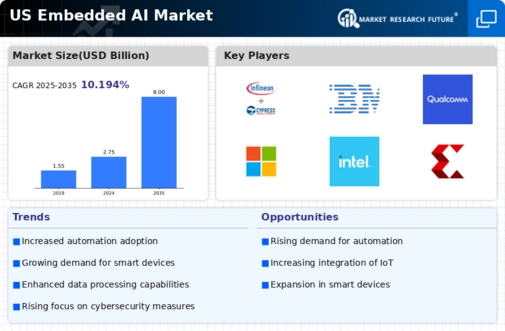Rising Demand for Smart Devices
The embedded ai market is experiencing a notable surge in demand for smart devices across various sectors. As consumers increasingly seek enhanced functionality and automation, manufacturers are integrating AI capabilities into everyday products. This trend is particularly evident in home automation systems, wearables, and smart appliances. According to recent data, the market for smart home devices is projected to reach $174 billion by 2025, indicating a robust growth trajectory. This rising demand is driving innovation within the embedded ai market, as companies strive to develop more sophisticated and user-friendly solutions. The integration of AI not only improves device performance but also enhances user experience, making it a critical driver in the embedded ai market industry.
Increased Focus on Energy Efficiency
Energy efficiency has become a paramount concern in the embedded ai market, particularly as industries strive to reduce operational costs and environmental impact. The integration of AI technologies into energy management systems allows for smarter consumption patterns and optimization of resources. For example, AI-enabled smart grids can analyze energy usage data to predict demand and adjust supply accordingly, potentially reducing energy waste by 20-30%. This focus on sustainability is not only beneficial for the environment but also aligns with regulatory pressures and consumer preferences for greener solutions. Consequently, the drive towards energy efficiency is a significant factor influencing the embedded ai market industry, as companies seek to innovate and meet these evolving demands.
Regulatory Support for AI Integration
Regulatory support for the integration of AI technologies is emerging as a significant driver in the embedded ai market. Government initiatives aimed at promoting AI adoption across various sectors are creating a favorable environment for innovation. For instance, policies that encourage the development of smart infrastructure and autonomous systems are likely to stimulate growth in the embedded ai market. Additionally, funding programs and grants for AI research are becoming more prevalent, further supporting the industry. As regulatory frameworks evolve to accommodate AI technologies, the embedded ai market industry is poised to experience accelerated growth, driven by both public and private sector collaboration.
Advancements in Machine Learning Algorithms
Recent advancements in machine learning algorithms are significantly influencing the embedded ai market. These innovations enable devices to process data more efficiently and make real-time decisions, which is essential for applications in various fields such as industrial automation and robotics. The ability to deploy complex algorithms on smaller, embedded systems is transforming how industries operate. For instance, the manufacturing sector is increasingly adopting AI-driven predictive maintenance solutions, which can reduce downtime by up to 30%. This trend highlights the potential of machine learning to optimize operations and reduce costs, thereby propelling growth in the embedded ai market industry. As these algorithms continue to evolve, they are likely to unlock new applications and opportunities within the market.
Growing Investment in Research and Development
Investment in research and development (R&D) is a critical driver of growth in the embedded ai market. Companies are allocating substantial resources to explore new technologies and applications, which fosters innovation and enhances competitive advantage. In the US, R&D spending in the technology sector has seen a steady increase, with estimates suggesting that it could reach $200 billion annually by 2026. This influx of funding is likely to accelerate advancements in AI capabilities, leading to more sophisticated embedded solutions. As organizations prioritize R&D, the embedded ai market industry is expected to benefit from a continuous stream of innovative products and services that meet the evolving needs of consumers and businesses alike.

















Leave a Comment